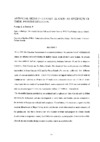Identificador persistente para citar o vincular este elemento:
https://accedacris.ulpgc.es/handle/10553/76927
| Campo DC | Valor | idioma |
|---|---|---|
| dc.contributor.author | Haroun, R. | en_US |
| dc.contributor.author | Herrera, R. | en_US |
| dc.date.accessioned | 2020-12-22T15:44:57Z | - |
| dc.date.available | 2020-12-22T15:44:57Z | - |
| dc.date.issued | 1995 | en_US |
| dc.identifier.uri | https://accedacris.ulpgc.es/handle/10553/76927 | - |
| dc.description.abstract | Since 1989, the Canarian Autonomous Government promoted the construction of artificial reefs aiming to enhance artisanal fisheries in shallow coastal areas of the Canary lslands. At present time. four artificial reef are deployed on sandy/rocky bottoms between 18 and 26 m depth in Lanzarote. Gran Canaria and La Palma lslands. The design of those reefs presents two different approaches. In Gran Canaria (GC) and La Palma lslands (P). they are build with five different types of concrete modules (from 1.2 to 8.5 m.t.) inside a rectangular surface of 24,000 m2 with 84 modules in GC, whereas in P there are 52 modules in a triangular surface of 15.300 m2. In the other hand, the two reefs of Lanzarote lsland were constructed with 35/34 concrete modules of only one alveolar type (9.1 m.t.) in a rectangular surface of 9,800 m2 respectively. The diversified habitat provided by the artificial reef complexes of Gran Canaria and La Palma enhanced the settlement and later development of more fishes and benthic species compared to the modules of Lanzarote artificial reef complexes. Nevertheless, it is necessary to point out the constant disturbance of illegal fishing in the reef domain which determined an underestimation of fish production. The future development of a broader artificial reef program in Canary lslands should obtain a compromise among local fishermen activities, oceanographic characteristics of the selected site and modules design in order to achieve more successful results. | en_US |
| dc.language | eng | en_US |
| dc.publisher | Japan International Marine Science and Technology Federation | en_US |
| dc.source | Proceedings Ecoset-95, Tokio, Japan International Marine Science and Technology Federation, v. 2, p. 727-731. | en_US |
| dc.subject | 241705 Biología marina | en_US |
| dc.subject.other | Artificial reefs | en_US |
| dc.subject.other | Canary islands | en_US |
| dc.title | Artificial reefs in Canary Islands : an overview of their present situation | en_US |
| dc.type | info:eu-repo/semantics/conferenceobject | en_US |
| dc.type | ConferenceObject | en_US |
| dc.relation.conference | Ecoset-95 | en_US |
| dc.description.lastpage | 731 | en_US |
| dc.description.firstpage | 727 | en_US |
| dc.relation.volume | 2 | en_US |
| dc.investigacion | Ciencias | en_US |
| dc.type2 | Actas de congresos | en_US |
| dc.description.numberofpages | 5 | en_US |
| dc.utils.revision | Sí | en_US |
| dc.identifier.ulpgc | Sí | en_US |
| dc.contributor.buulpgc | BU-BAS | en_US |
| item.fulltext | Con texto completo | - |
| item.grantfulltext | open | - |
| crisitem.author.dept | GIR ECOAQUA: Biodiversidad y Conservación | - |
| crisitem.author.dept | IU de Investigación en Acuicultura Sostenible y Ec | - |
| crisitem.author.dept | Departamento de Biología | - |
| crisitem.author.orcid | 0000-0003-1348-692X | - |
| crisitem.author.parentorg | IU de Investigación en Acuicultura Sostenible y Ec | - |
| crisitem.author.fullName | Haroun Tabraue, Ricardo Jesús | - |
| Colección: | Actas de congresos | |
Visitas
120
actualizado el 20-jul-2024
Descargas
60
actualizado el 20-jul-2024
Google ScholarTM
Verifica
Comparte
Exporta metadatos
Los elementos en ULPGC accedaCRIS están protegidos por derechos de autor con todos los derechos reservados, a menos que se indique lo contrario.
